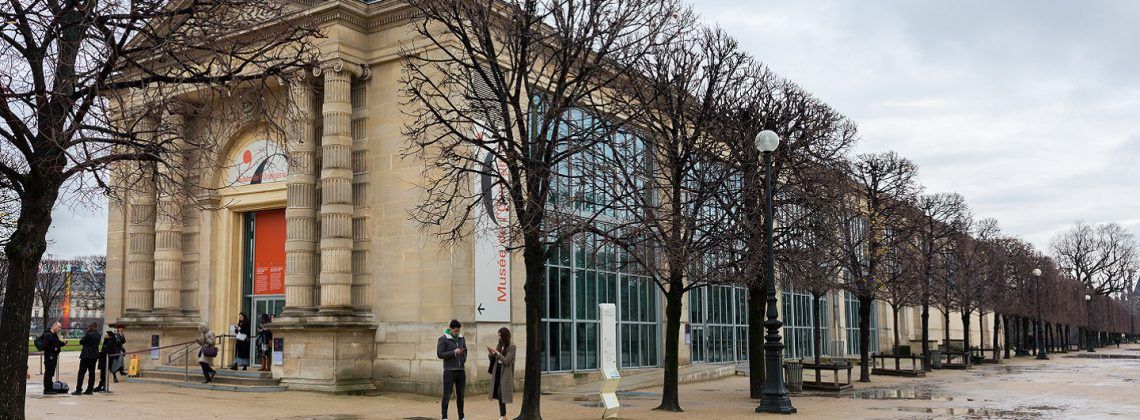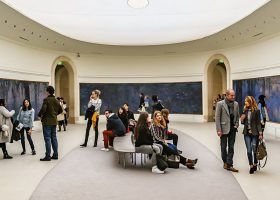Come for one of the most impressive displays of Monet’s Water Lilies in the world, but stay to explore the historic building that houses them. The Musée de l’Orangerie is in what was once the greenhouse of the Tuileries Palace where many French rulers lived before it was burned down. In this guide, find out how to visit the Musee de l’Orangerie from tickets to tours, what to see, and more.
Pro Tip: Planning what to do on your trip to Paris? Bookmark this post in your browser so you can easily find it when you’re in the city. Check out our guide to Paris for more planning resources, our top Paris tours for a memorable trip, and the best things to do in Paris.
Visiting the Musée de l’Orangerie: What We’ll Cover
Paris is bursting at the seams with amazing art museums. If you haven’t heard of this gem of a modern art gallery, that’s probably because it’s relatively small. Have no fear! It makes up for the smaller size by showcasing some world-class art.
The Musée de l’Orangerie is tucked away in one corner of the Tuileries Gardens—the opposite end of the gardens from the Louvre and across the river from Musée d’Orsay. That means you can either reach it from Place de la Concorde or by passing through the gardens. Both are great options!
Believe it or not, this prestigious museum was originally a greenhouse. It was used primarily for growing citrus trees for the royal family who lived in the nearby Tuileries Palace.
According to French historian Hilary Ballon, the palace burned to the ground during a rebellion in 1871. After that, the French government took over the Orangerie. Some 50 years later in 1922, architects transformed it into an art gallery.
I’ve put together this thorough guide to help you make the most of your visit to the Musée de l’Orangerie. Here’s what we’ll cover:
- Hours, info, and tickets
- How much time to budget
- How to get there
- What to see
- Guided tours
- Facts and history
- Places to eat nearby
Not ready to book a tour? See if Paris tours are worth it.
Musée de l’Orangerie: Hours and Tickets
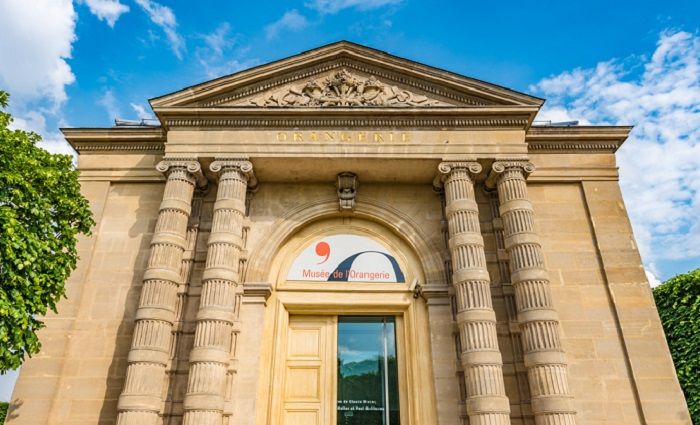
Musée de l’Orangerie Hours:
Open: Wednesday – Monday: 9 am – 6 pm. Last admission is at 5:15 pm. Rooms close at 5:45 pm.
Closed: Closed on Tuesdays. The museum is also closed on May 1, the morning of July 14, and all day on December 25.
Musée de l’Orangerie Tickets:
Full Admission: €12.50
1 Adult accompanying a child: €10
Under 18: Free
Special exhibitions are included in the general admission fee
Free Days: Entrance is free for all visitors on the first Sunday of each month.
Online Ticket Purchase: The museum recommends making a reservation online in advance, which I highly suggest since timed tickets will give you priority access. Tickets are good for 30 minutes after the time stamp (on your online reservation), so plan ahead to arrive on time!
Address: Tuileries Garden, Southwest Corner
Things to Know:
The cloakroom is free for ticket holders. However, the museum only allows bags the size of a backpack or smaller. Photography in the museum is not permitted under any circumstances.
How Much Time to Budget for the Musée de l’Orangerie
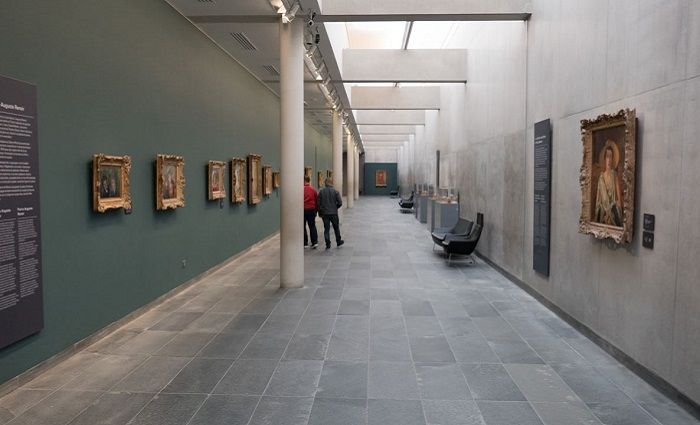
Short answer: You can probably visit this museum in just 45 minutes, which is the perfect activity between the other things you want to do in Paris.
As I mentioned, this is a much smaller museum than what you’re probably used to in Paris. So, why only 45 minutes? First, you can see all of the artworks in the entire museum in 45 minutes or less.
I recommend visiting the Orangerie’s permanent collection on Level -2 first. From there, you will need about 30 minutes to see everything else. Finally, I recommend budgeting another 15-30 minutes just for seeing Monet’s Water Lilies paintings.
How to Get to the Musée de l’Orangerie
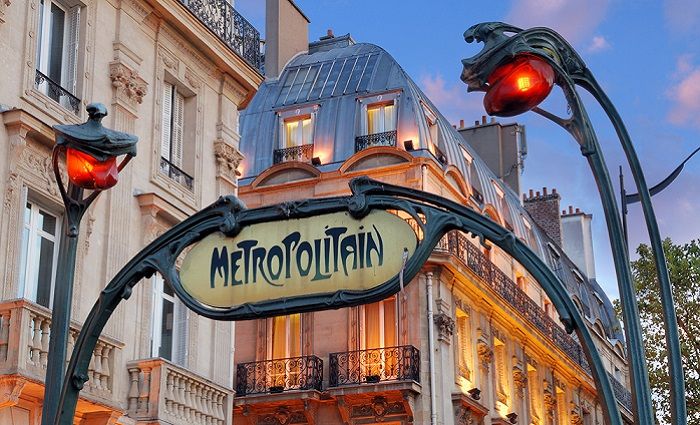
The Musée de l’Orangerie is at the southwest end of the Tuileries Gardens. So, it is directly east of the bustling Place de la Concorde. On the northwest corner, you’ll find the Jeu de Paume, an arts center for video and photography. It was once a royal arena for playing tennis!
The Paris metro and buses are very easy to navigate and are an inexpensive way to get around the city. City passes are available online through the official Paris public transit site, the RATP. You can also purchase one-ride and multi-ride tickets in bulk at each metro station. While you’re at the station, ask for a map from the ticket seller. Or you can download bus and metro maps onto your phone from the RATP site.
Metro
The metro is the easiest way to get around Paris! Three different Paris metro lines stop near the Musée de l’Orangerie: 1, 8, and 12. All stops are called Concorde, so just look for that station name.
Pro Tip: Paris metro tickets are quite small. Play it safe and put your validated, one-ride ticket somewhere safe so you don’t lose it as you hop on and off the Metro. Transit police will sometimes check passengers’ tickets as they’re leaving metro stations, so be vigilant. In a few large stations such as Chatelet-Les Halles, you will need your validated ticket to exit.
Bus
Several bus lines have stops near the Musée de l’Orangerie. The closest stop is Concorde and the lines are: 42, 45, 52, 72, 73, 84, and 94.
Bike (Vélib)
If you’re a confident urban biker, then consider biking. You can rent a traditional bike or an e-bike through Paris’ Vélib bike share. That’s easy to do since there are 1,400 or so docking points in the city. Also, 40 percent of the bikes are now electric, which makes them an environmentally friendly option too.
Vélib e-bike stations Near the Musée de l’Orangerie:
- Cambon-Rivoli (#1020)
- Assemblée Nationale (#7009)
- Quai Anatole France-Musée d’Orsay (#7110)
- Quai d’Orsay-Invalides (#7112)
Pro Tip: Paris has many miles of dedicated bike lanes. Also, the city keeps adding more of them. Some districts are car-free, too. The Vélib program doesn’t rent helmets so you will need to bring your own.
Driving and Parking
It can be challenging to drive in Paris. Why? For one thing, the streets are almost always busy. For another, finding parking spots in the historic center is nearly impossible. In addition, parking lots can be expensive and metered parking on the streets may be confusing to figure out. Lastly, open spots are hard to find. Consequently, I don’t recommend driving to the Musée de l’Orangerie.
If you do decide to drive, there are a few parking garages near the museum:
- Place de la Concorde (corner of Avenue Gabriel and Place de la Concorde)
- Pyramides (15, Rue des Pyramides)
- Carrousel du Louvre (access by Avenue du Général Lemonnier)
What to See and Do at the Musée de l’Orangerie
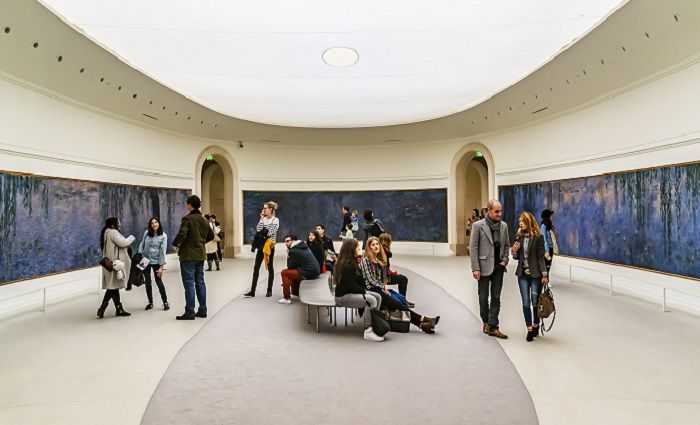
As you plan your visit to the Musée de l’Orangerie, you’ll want to know how to navigate the museum and where the iconic pieces are. The galleries of the Musée de l’Orangerie are arranged on three levels:
- Monet’s Water Lilies: Niveau (Level) 0/Ground Floor
- Cafe and Boutique: Level -1
- Permanent Collection: Level -2
Claude Monet’s Nymphéas (Water Lilies): Level 0
The museum built two special, oval-shaped galleries to display Monet’s eight large Water Lilies paintings. As a result, it feels like you get a panoramic view of the great master’s famous water lily pond. As you’ll see, it is an immersive, peaceful experience.
- Gallery 2: Clouds, Sunset, Green Reflections, Matin
- Gallery 3: Reflections of Trees, Clear Morning in the Willows, The Two Willows, Morning in the Willows
The Permanent Collection: The Arts of Paris: Level -2
The permanent collection displays artworks from the early 20th century. Most of the artworks were made by Parisians. Since Musée de l’Orangerie is an impressionism and post-impressionism museum, there’s plenty to see here from artists beyond the famous Claude Monet.
You can read more detailed information about the things to see here at Orangerie if you want. Here’s a short list of some of the major works you won’t want to miss:
- Henri Matisse, Women on the Couch or The Divan, Room 8
- Amedeo Modigliani, Paul Guillaume, New Pilot, Room 8
- Auguste Renoir, Young Girls at the Piano, Room 9
- Paul Cézanne, Apples and Cookies, Room 10
- Pablo Picasso, Large Bather, Room 11
- Maurice Utrillo, The Town Hall with the Flag, Room 14
- Chaïm Soutine, The Little Pastry Cook, Room 15
Tour Options for the Musée de l’Orangerie
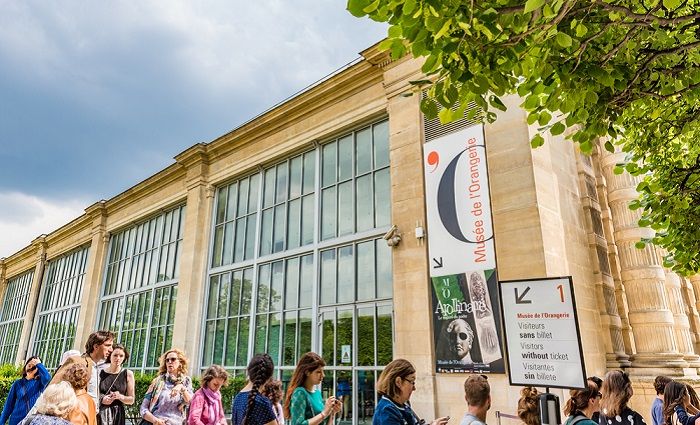
Audio Guides
The Musée de l’Orangerie is small, so you don’t have to book a tour, though it’s always recommended so you can learn the most about the pieces and the artists here. Otherwise, you can rent an audio guide for the modest price of €5.00 per adult. These devices are available at the audio guide desk in the entrance area.
Audio guides are available in English and French. Finally, the audio guides include information about the permanent collection and special exhibitions. All of the text is written by the museum’s curators.
Museum Brochure and Map
You can download the printed guide to the museum, which includes maps of each floor. The galleries of the permanent collection are organized according to artists. Alternatively, you can pick up one of the printed guides when you’ve been admitted to the museum.
Not ready to book a tour? Check out our best Paris tours to take and why.
Facts and History of the Musée de l’Orangerie
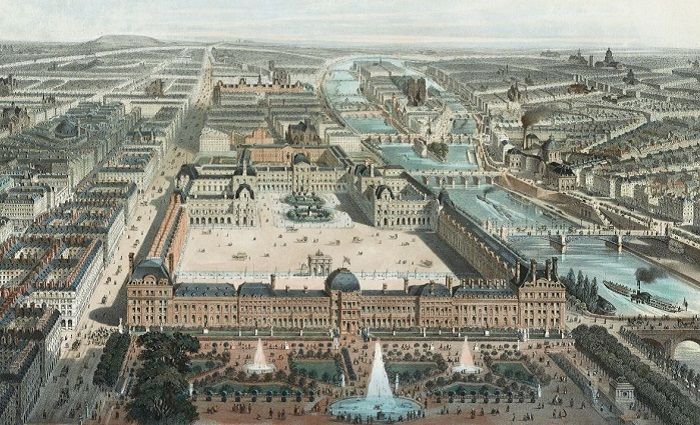
Not only is the art in the Musée de l’Orangerie an important part of French history, but so is the museum itself! Here are some fascinating facts from French historian M.F. Mansfield about this historic building to get you excited about your upcoming visit.
- The building in which the present museum is housed used to be a greenhouse in the Tuileries Garden near the current-day Louvre Museum. It was called “l’Orangerie” because orange trees were kept there in the wintertime. According to Mansfield, it was built in 1852.
- French rulers, including Napoleon Bonaparte, who lived in the nearby Tuileries Palace were the beneficiaries of the oranges. The palace itself had been there since the late 16th century! It was much grander than the Louvre in its heyday!
- This opulent royal residence had been home to several generations of French royalty. However, it was a symbol of royal excess for many regular Parisians. So, during an uprising called the Paris Commune in 1871, it was torched. According to Mansfield, the Empress Eugenie, wife of Napoleon III, had to flee with her ladies in waiting.
- Very little remains of the palace. Here and there in the Tuileries Gardens, though, you can see remnants of the long-gone palace. Look for archways and columns that don’t hold anything up.
- After the fire, the Orangerie fell out of use. So, in 1922, the French government decided to convert it into an art gallery.
- In 1921 after World War I had ended, the government gave the building to the Ministry of Arts. As fate would have it, Claude Monet was painting his huge Water Lilies panels around the same time.
- Monet decided to donate the eight huge paintings to the French people, notes Pierre Georgel. Specifically, the artist wanted the paintings to symbolize peace.
Places to Eat Nearby
The Musée de l’Orangerie is located in the 1st arrondissement in the very heart of old Paris. Therefore, restaurant options are many. If you’d like to visit the Tuileries Gardens after your visit, there are a few dining options near the museum. Otherwise, choose from several options, none inexpensive, on the Right Bank.
- Rosa Bonheur la Crêperie: | € | This charming little crêperie serves the iconic, thin French pancakes and are light in color. In constrast, galettes, made from buckwheat, are traditionally savory and a little darker. They are the dessert portion of the meal, so have both! My favorite galette is the basic one with egg, cheese, and ham. For dessert, I go for a crêpe topped with apples, warm salted caramel, and whipped cream!
- Le Soufflé | $$ | I can’t visit the Musée de l’Orangerie or the Louvre without dining afterwards at Le Soufflé. What could be more iconically French—besides a crêpe—than a soufflé? I always have the onion soup, cheese soufflé, and salad option. Don’t leave without trying the chocolate soufflé!
- Maxim’s | $$$$ | Maxim’s across the Place de la Concorde is basically a Parisian institution. Make a reservation ahead of time so you are guaranteed a table. Go for the caviar, foie gras, and gorgeous Art Nouveau decor. Stay for the lobster caught fresh in nearby Brittany!
- Brasserie le Bourbon | $$ | For something a bit more relaxed, head south across the Pont de la Concorde to this charming brasserie. I recommend the crab salad or the veal, but everything here is delicious!
Not ready to book a tour? Find out if Paris tours are worth it.
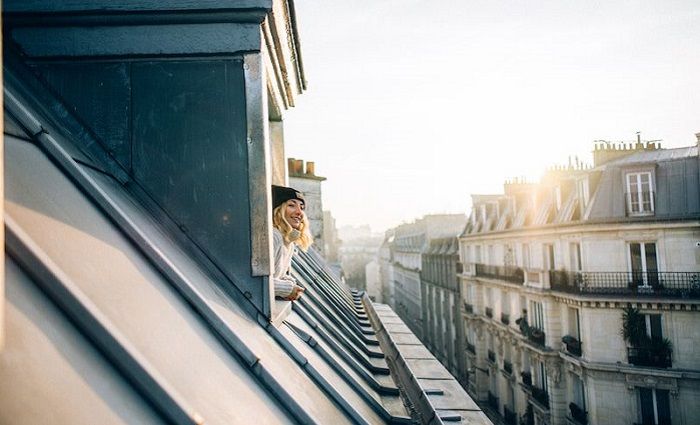
Where To Stay in Paris
With a city as magnificent as Paris, it can be hard to find the perfect hotel at the perfect price. Explore the best hotels and places to stay in these incredible neighborhoods in Paris.
